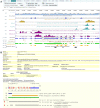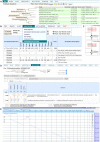PhycoCosm, a comparative algal genomics resource
- PMID: 33104790
- PMCID: PMC7779022
- DOI: 10.1093/nar/gkaa898
PhycoCosm, a comparative algal genomics resource
Abstract
Algae are a diverse, polyphyletic group of photosynthetic eukaryotes spanning nearly all eukaryotic lineages of life and collectively responsible for ∼50% of photosynthesis on Earth. Sequenced algal genomes, critical to understanding their complex biology, are growing in number and require efficient tools for analysis. PhycoCosm (https://phycocosm.jgi.doe.gov) is an algal multi-omics portal, developed by the US Department of Energy Joint Genome Institute to support analysis and distribution of algal genome sequences and other 'omics' data. PhycoCosm provides integration of genome sequence and annotation for >100 algal genomes with available multi-omics data and interactive web-based tools to enable algal research in bioenergy and the environment, encouraging community engagement and data exchange, and fostering new sequencing projects that will further these research goals.
© The Author(s) 2020. Published by Oxford University Press on behalf of Nucleic Acids Research.
Figures




References
-
- Pierella Karlusich J.J., Ibarbalz F.M., Bowler C.. Phytoplankton in the Tara Ocean. Annu. Rev. Mar. Sci. 2020; 12:233–265. - PubMed
-
- Keeling P.J. The number, speed, and impact of plastid endosymbioses in eukaryotic evolution. Annu. Rev. Plant Biol. 2013; 64:583–607. - PubMed
-
- Armbrust E.V., Berges J.A., Bowler C., Green B.R., Martinez D., Putnam N.H., Zhou S., Allen A.E., Apt K.E., Bechner M. et al. .. The genome of the diatom Thalassiosira pseudonana: ecology, evolution, and metabolism. Science. 2004; 306:79–86. - PubMed
-
- Read B., Kegel J., Klute M., Kuo A., Lefebvre S.C., Maumus F., Mayer C., Miller J., Monier A., Salamov A. et al. .. Pan genome of the phytoplankton Emiliania underpins its global distribution. Nature. 2013; 499:209–213. - PubMed

